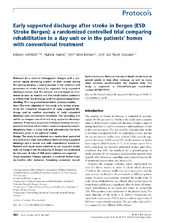Early supported discharge after stroke in Bergen (ESD Stroke Bergen): a randomized controlled trial comparing rehabilitation in a day unit or in the patients’ homes with conventional treatment
Peer reviewed, Journal article
Published version
Permanent lenke
https://hdl.handle.net/1956/10706Utgivelsesdato
2013-10Metadata
Vis full innførselSamlinger
Originalversjon
https://doi.org/10.1111/j.1747-4949.2012.00825.xSammendrag
Rationale: As a result of demographic changes with a presumed rapidly increasing number of older people during the coming decades, a strong increase in the incidence and prevalence of stroke should be expected. Early supported discharge implies that the patients are discharged to their homes as soon as feasible and that rehabilitative treatment is offered after the discharge, with the patients being homedwelling. This has proved beneficial in previous studies. Aims: The main objective of this study is to further characterize the important components of early supported discharge and to confirm superiority of early supported discharge over conventional treatment. The secondary aim will be to compare two different early supported discharge schemes. These early supported discharge schemes are composed of intensive rehabilitation treatment given by a multidisciplinary team in a day unit and, alternatively, the same treatment given in the patients’ homes. Design: The study is conducted as a randomized controlled trial with three arms: two different forms of early supported discharge and a control arm with conventional treatment. Patients with acute stroke admitted to our hospital’s stroke unit and living in the Municipality of Bergen are considered for inclusion. A total of 350 stroke patients are expected. Study outcomes: Primary outcome is modified Rankin Scale six-months after inclusion. Secondary outcomes include Barthel Index and National Institute of Health Stroke Scale at several points in time after inclusion, as well as many other schemes, questionnaires and physical tests. The study is registered in ClinicalTrials.gov registration number NCT00771771.
